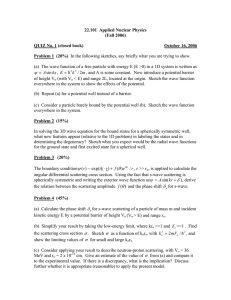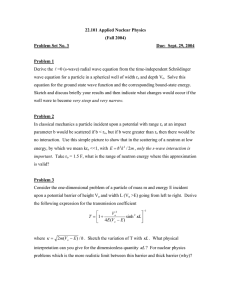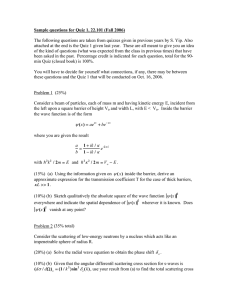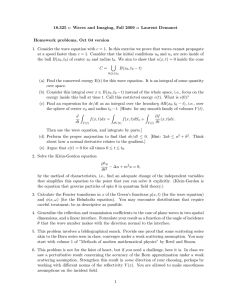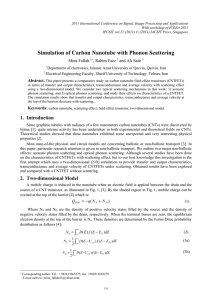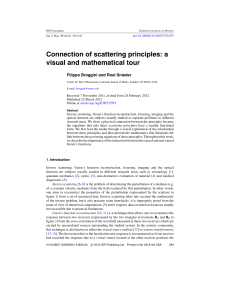Sample questions for Quiz 1, 22.101 (Fall 2004)
advertisement
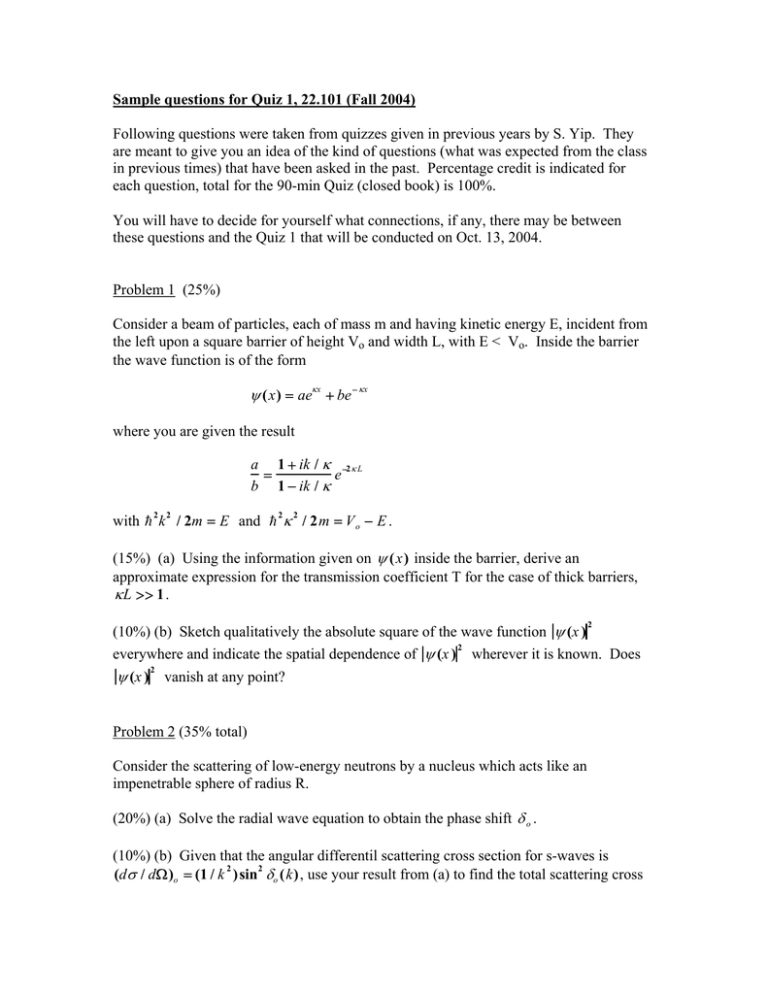
Sample questions for Quiz 1, 22.101 (Fall 2004) Following questions were taken from quizzes given in previous years by S. Yip. They are meant to give you an idea of the kind of questions (what was expected from the class in previous times) that have been asked in the past. Percentage credit is indicated for each question, total for the 90-min Quiz (closed book) is 100%. You will have to decide for yourself what connections, if any, there may be between these questions and the Quiz 1 that will be conducted on Oct. 13, 2004. Problem 1 (25%) Consider a beam of particles, each of mass m and having kinetic energy E, incident from the left upon a square barrier of height Vo and width L, with E < Vo. Inside the barrier the wave function is of the form ψ (x) = aeκx + be − κx where you are given the result a 1 + ik / κ −2 κ L = e b 1 − ik / κ 2 2 2 2 with h k / 2m = E and h κ / 2 m = V o − E . (15%) (a) Using the information given on ψ ( x) inside the barrier, derive an approximate expression for the transmission coefficient T for the case of thick barriers, κ L >> 1 . (10%) (b) Sketch qualitatively the absolute square of the wave function ψ (x ) 2 everywhere and indicate the spatial dependence of ψ (x ) wherever it is known. Does 2 ψ (x ) vanish at any point? 2 Problem 2 (35% total) Consider the scattering of low-energy neutrons by a nucleus which acts like an impenetrable sphere of radius R. (20%) (a) Solve the radial wave equation to obtain the phase shift δ o . (10%) (b) Given that the angular differentil scattering cross section for s-waves is 2 2 (dσ / dΩ)o = (1 / k )sin δo ( k) , use your result from (a) to find the total scattering cross section σ o . Suppose we apply this calculation to n-p scattering and use for R the radius of the deuteron, R = h m n E B , where mn is the neutron mass and EB is the ground state energy of the deuteron. Find R in unit of F (1 F = 10-13 cm), and σ o in barns. (5%) (c) Does your result agree with the experimental value of neutron scattering cross section of hydrogen? If not, explain the reason for the discrepancy. Problem 3 (25%) (a) Calculate the phase shift δo for s-wave scattering of a particle of mass m and incident energy E by a potential barrier V(r) = Vo, r < ro, and V(r) = 0, r > ro, with E < Vo. (b) Simplify your result by going to the limit of low-energy scattering. Examine the total scattering cross section σ = (4 π sin2 δ o ) / k 2 in this limit. Sketch σ as a function of k o ro , where k o2 = 2mVo / h2 and indicate the value of σ in the infinite barrier limit, k o ro → ∞ . Problem 4 (25%) Consider a one-dimensional wave equation with the potential − L1 ≤ x ≤ L1 (region 1) V1 − L2 ≤ x ≤ − L1 , L1 ≤ x ≤ L2 (region 2) 0 otherwise (region 3) -Vo V(x) = (a) Find the x-dependence of the wave function in each of the 3 regions for E < 0 (b) What are the boundary conditions to be applied at the interface? (You are asked to state the boundary conditions, but not to apply them.) Problem 5 (20%) A particle of mass m is just barely bound by a one-dimensional potential well of width L. Find the value of the depth Vo. Problem 6 (25%) Suppose you are given the result for the transmission coefficient T for the barrier penetration problem, one-dimensional barrier of height Vo extending from x=0 to x=L, ⎡ ⎤ Vo2 T = ⎢1 + sinh 2 KL ⎥ ⎣ 4 E (Vo − E) ⎦ −1 where K 2 = 2m(Vo − E ) / h 2 is positive (E < Vo). (a) From the expression given deduce T for the case E > Vo without solving the wave equation again. (b) Deduce T for the case of a square well potential from the result for a square barrier.
